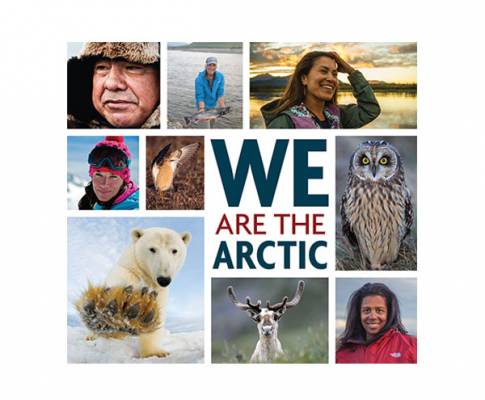The fight over protecting the Arctic National Wildlife Refuge is an archetype of conservation politics. The coastal plain of the Refuge is an invaluable biological, spiritual, and cultural resource, our “last true wilderness,” “America’s Serengeti.” Drilling proponents say it’s oil-rich; we need more domestic energy; Alaska’s economy depends on oil revenues; environmental impacts can be mitigated. The question, then, is whether the oil and its putative economic benefits are worth the environmental costs.

We are comfortable with this “balancing” narrative. It’s a tug-of-war we understand; whichever side you’re on, you know right where to pull. But now that the climate crisis is upon us, it makes no sense.
The potential for oil production in the Arctic Refuge isn’t the best reason to lift wildlife protections and allow drilling. It’s the most compelling reason to strengthen those protections. Foregoing oil development isn’t a cost to be weighed against environmental values. It’s the only durable way to protect those values…and pretty much everything else.
Yes, the coastal plain of the Arctic Refuge would be well worth protecting for the extraordinary intrinsic values of what’s on top of the tundra — the caribou migration and the Gwich’in culture that depends on it, the globally significant bird habitat, the polar bears, musk oxen, grizzlies, fox, wolves….. Arctic protection advocates have documented these values exquisitely; break your heart here and here and here and here….
But none of these values can be protected if we don’t step up to the climate crisis, and that means not disturbing what’s under the tundra. The challenge is shockingly simple and well-understood. We have to keep roughly 80% of proven fossil fuel reserves in the ground, or we’re toast. Arctic ecosystems would be ravaged by unchecked climate disruption sooner and worse than most. But no one — no place — would escape the devastation. We would forfeit, in Jim Hansen’s immortal words, the chance to preserve “a planet similar to that on which civilization developed and to which life on Earth is adapted.”
The choice is stark. Either we end the Fossil Fuel Age over the next several decades, using up to 20% of proven reserves (which is still a lot) over the course of the transition, in which case we might yet salvage a decent future. Or we let big Oil keep digging and drilling, exhausting all the cheap oil reserves and then going after the unproven and more expensive stuff in the Arctic. This would trigger – is triggering – a radical transformation of the planet. Food supplies would dwindle. Most species would go extinct. Island nations and coastal cities would disappear. Climate impacts would displace whole cultures and destabilize societies. Polar bears and caribou would be snowballs in Hell.
It’s hard to imagine a better place than the Refuge for President Obama to put a stake in the ground marking his choice between these two futures. It’s ground zero for climate consequences; temperatures are soaring most rapidly near the poles, and with pack ice retreating in the Arctic Ocean, polar bears are relying more heavily on the coastal plain for denning, while coastal villages are falling into the sea.
But the Arctic isn’t just a hot spot for climate consequences. This battle is about whether we will confront the principle cause of the crisis – continuing development of fossil fuel supplies that must not be burned.
With the clean energy revolution hitting full stride, there is every reason to believe we CAN make a successful transition from fossil fuels to clean energy by mid-century. Clean energy can produce far more and better jobs, and more broadly-shared economic opportunity than fossil fuels. We should help Alaska make this transition well and fairly, but not prolong it.
In the midst of escalating climate disasters and moral awakening, there’s no doubt that we MUST make this transition. Whatever costs we incur will be a small fraction of the cost of failing to do so and letting the climate collapse.
The crucial remaining question is whether we WILL make this transition – whether we have the vision and the guts to stand up to the entrenched power of the fossil fuel industry and do what we know is right and necessary.
President Obama has clearly signaled his intent to help us find that will. In rejecting the Keystone XL pipeline, helping to forge the Paris Climate Agreement, doubling fuel economy standards, and implementing the Clean Power Plan, he’s backed up that intent with meaningful action. But the transition has begun too slowly and timidly. We lost too much time waffling with a senseless “all of the above” energy policy, and now the climate crisis is upon us.
We can no longer move forward and backward at the same time. If we’re going to change the climate prognosis for the better, we have to stop making it worse, decisively and immediately. We can’t burn most of the cheap oil we’ve already got. So if the Paris Agreement and the intergenerational contract mean anything, it’s time to stop exploring for more.
Preserving Arctic habitat won’t save the caribou or the polar bears or the people who depend on them if we don’t stabilize the climate. There’s no refuge for them, or us, unless we keep that oil in the ground.
Candidate Obama urged us to “be the generation that finally frees America from the tyranny of oil.” President Obama can strike a parting blow for that freedom by protecting the Arctic Refuge – not in spite of its oil potential, but because of it.
Urge him on, right here: We Are the Arctic